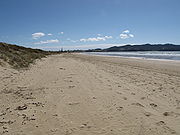
Whatuwhiwhi
Encyclopedia

Karikari Peninsula
The Karikari Peninsula is a right-angled land mass of two relatively-distinct parts. The rocky northern part, which has an east-west orientation and is approximately 17km long, was originally an island.. It is connected to the rest of the Northland Region of New Zealand by a low sandy strip...
of Northland, New Zealand
New Zealand
New Zealand is an island country in the south-western Pacific Ocean comprising two main landmasses and numerous smaller islands. The country is situated some east of Australia across the Tasman Sea, and roughly south of the Pacific island nations of New Caledonia, Fiji, and Tonga...
. To the south is Doubtless Bay.
Kaitaia
Kaitaia
Kaitaia is a town in the far north region of New Zealand, at the base of the Aupouri Peninsula which is about 160 km northwest of Whangarei. It is the last major settlement on the main road north to the capes and bays on the peninsula...
is about 39 km away.
There are three shaded and sandy coves. Swimming is safe, but it is not a good anchorage because it is exposed to the south-east.
de Surville
French explorer Jean-François-Marie de SurvilleJean-François-Marie de Surville
Jean-François-Marie de Surville was a French trader and navigator.In 1767 de Surville set sail in his ship, the St Jean Baptiste to India to trade between the French settlements in India and China...
and his crew in the ship St Jean Baptiste were the first Europeans to enter Doubtless Bay, just 8 days after James Cook
James Cook
Captain James Cook, FRS, RN was a British explorer, navigator and cartographer who ultimately rose to the rank of captain in the Royal Navy...
had named it. They anchored off Brodie's Creek, just north east of Whatuwhiwhi, on 17 December 1769, and gathered cresses and green plants gathered by the shores. Here Father Paul-Antoine Léonard de Villefeix
Paul-Antoine Léonard de Villefeix
Paul-Antoine Léonard de Villefeix OP was a French Dominican priest. He conducted the first Christian service in New Zealand. He was the chaplain of French navigator and explorer Jean-François-Marie de Surville when de Surville, in his ship, the St Jean Baptiste, sighted the North Island of New...
(chaplain on the St Jean Baptiste) conducted the first Christian service in New Zealand waters when he celebrated Mass
Mass
Mass can be defined as a quantitive measure of the resistance an object has to change in its velocity.In physics, mass commonly refers to any of the following three properties of matter, which have been shown experimentally to be equivalent:...
on Christmas Day 1769. A storm on 27 December stranded a party of men on shore at Whatuwhiwhi, where they were treated hospitably by the local Maori. In the same storm, the ship dragged her anchors, which had to be cut. The ship's yawl, which was in tow, struck rocks and was also cut free.
After the storm, and the stranded party had returned to the ship, on 31 December 1769, the yawl was spotted ashore on Tokerau Beach surrounded by Maori, and an armed party set off to retrieve it. They found a group of Maori carrying spears, and the chief, Ranginui, approached de Surville carrying a twig of green leaves as a sign of peace. De Surville arrested Ranginui for the theft of his boat. His party burned about 30 huts, destroyed one canoe filled with nets, and confiscated another. They brought Ranginui back to their ship, where the crew members who had been stranded during the storm identified him as the chief who had been hospitable to them. De Surville was determined to keep his captive, and St Jean Baptiste sailed for Peru the same day. Ranginui died in captivity, of scurvy, 12 weeks later.
A plaque commemorating this visit was unveiled at Whatuwhiwhi in 1969. The anchors abandoned during the storm were located and raised in a community effort on 21 December 1974.
Education

Te Kura Kaupapa Maori o Rangiawhia is a coeducational full primary (years 1-8) school with a decile rating
Socio-Economic Decile
Decile, Socio-Economic Decile or Socio-Economic Decile Band is a widely used measure in education in New Zealand used to target funding and support to more needy schools....
of 2 and a roll of 47. It is a Kura Kaupapa Māori
Kura Kaupapa Maori
Kura Kaupapa Māori are Māori-language immersion schools where the philosophy and practice reflect Māori cultural values with the aim of revitalising Māori language, knowledge and culture...
school which teaches fully in the Māori language
Maori language
Māori or te reo Māori , commonly te reo , is the language of the indigenous population of New Zealand, the Māori. It has the status of an official language in New Zealand...
.

